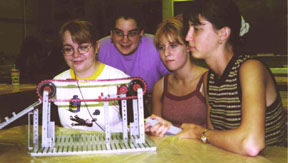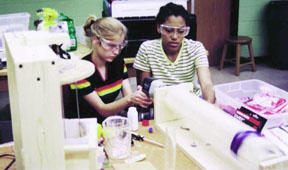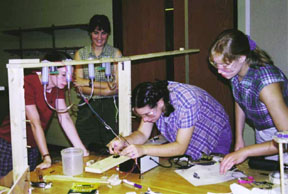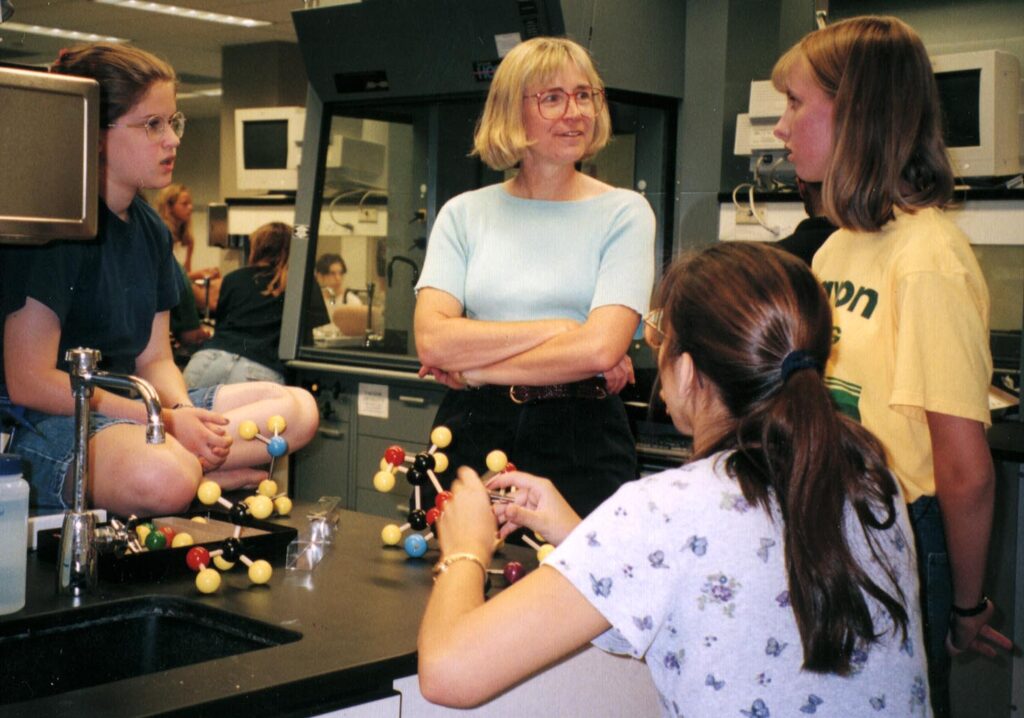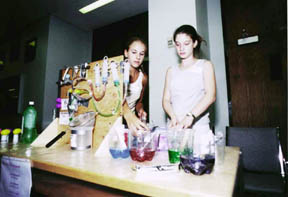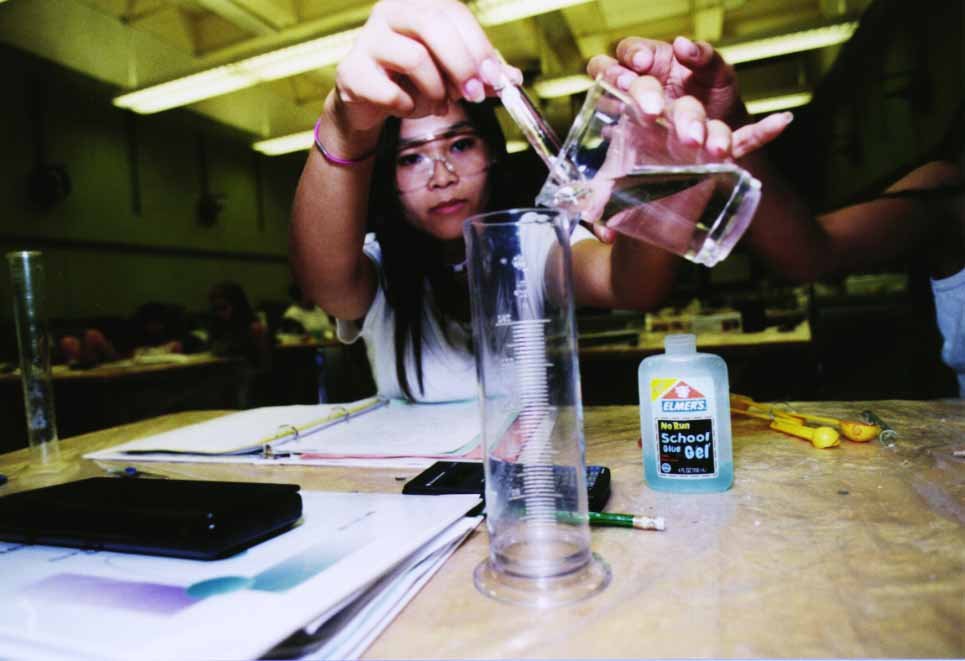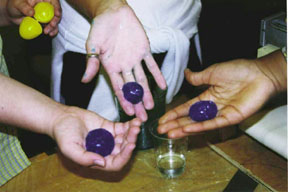
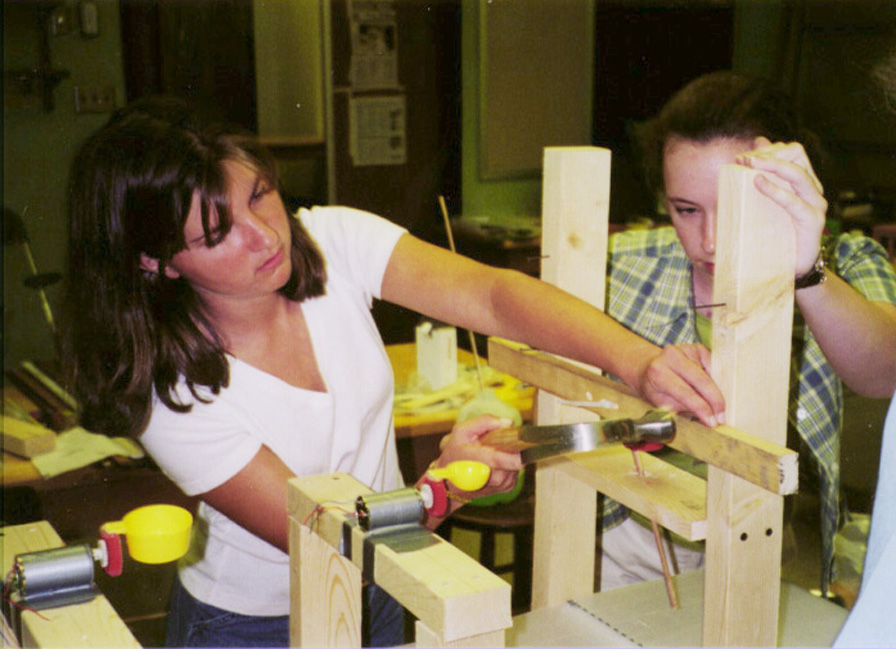
Introduction and Goals
The Academy is a residential institute for young women who had completed grades 9-11. The planning committee for the program consists of University of Missouri faculty from the departments of physics, industrial engineering, chemistry, mathematics, and science education, the K-12 science coordinator of the Columbia Public Schools, and a junior high school technology teacher. The second and third Newton Summer Science Academies were held July 1998 and 1999. The goals of the Academy are to provide
- hands-on integrated physical science experiences for female students,
- opportunities for students to meet women scientists who may serve as role models, and
- a peer group of female students who are interested in the physical sciences.
Integration of physical science activities
The activities is accomplished by having students design and build a polymer ball toy factory. Students use many products on a daily basis but rarely realize the multiple components that are required to produce them. By automating the production of polymer balls made of glue and borax students use a number of conceptual and hands-on skills. Examples of integrated activities and skills utilized are:
Examples of interdisciplinary learning
Mathematics is encountered in determining the optimal mix of glue and borax required for the highest bounce height. This problem is solved by a graphical method. Skills: computer programming, graphing.
The Engineering focus is on system design and factory layout. The construction of a material handling system involves the physics of gears, pulleys and electrical systems. Skills: Drafting, drawing, designing, design accuracy, wiring, construction skills such as hammering, drilling etc.
Chemical concepts encountered include polymer and acid-base chemistry, absorbance spectrophotometry, and waste generation. Skills: Measuring, calculating dilutions, spectroscopy.
Economy and cost-benefit analysis enters into budgeting the cost of building the factory. A construction store and lumber yard contain all the materials needed to complete the factory. Items in the store are purchased with Newton dollars. Skills: Managing and planning a budget.
Legal issues of patents and intellectual property are encountered via a patent bulletin board. Students patent equipment they have designed, and can sell patents to others. Skills: Patent development, evaluation of design for completeness and novelty.
Related activities
Reverse engineering: Taking apart Xerox machines, typewriters, CD players……Students salvage parts, particularly paper feeders for conveyor belts, and gears, motors, and pulleys for their factory.
Tours: University of Missouri-Columbia College of Engineering Manufacturing Laboratory (which has a basic conveyer belt and a programmable robot), the Unilever manufacturing facility in Jefferson City, Missouri and the Medical Physics department at Boone Hospital Center.
Gender related issues: The students view the Dateline NBC video featuring the Illinois Math and Science Academy all-female physics course and discuss their experiences as females in math and science classes. They also view excerpts of women scientists’ talks from the December 1995 NSF Women in Science Conference.
Meeting women scientists and engineers: Saturday lunch with a NASA scientist Bridget Landry (1998) and Linda Robeck (1999). Both have worked with the Mars Pathfinder Mission at the Jet Propulsion Laboratory in Pasadena. Students have time to interact with them personally, as well as see a science fiction movie with them.
Formal dinner with local women scientists and engineers, with a featured speaker, Ann Moore, an chemical engineer at Unilever (1998) and Sarah Moore, a chemical engineer from 3M in Columbia, Missouri (1999. University and school system administrators join the students for the evening.
Family (pizza) Night: Students demonstrate their factories to their families and friends. They sell their polymer balls to their families for Newton dollars – a big hit among the younger siblings!
Recruitment
Recruitment brochures are sent to the science teachers, who give the brochures to students that they recommend to the program. Approximately 30 students can be accommodated in the academy. About one half of the students have been rising sophomores, one third rising juniors, and the rest rising seniors.
Staff
University faculty and graduate students from the departments of chemistry, physics, math and industrial engineering, and science and industrial technology teachers from local schools team coordinate the daytime academic activities. Female graduate and undergraduate students serve as counselors and live in the dorms with the students.
Evaluation
On-site evaluation is conducted via several instruments, including a science course selection survey, an assertiveness survey, and a strong interest inventory survey. A follow up interview is scheduled for four months after the program. The responses to the academy are overwhelmingly positive. The factors repeatedly mentioned are the female peer group, the day with the NASA visitor, an increase in confidence level and participation in science classes, and the positive impression of the various female scientists they met during the academy.
Responses: Quotes from Newton Participants
I learned a lot from going to the engineering building. I enjoyed working with robots and programming them to do what you wanted them to do.
The speaker at the dinner with the scientists had the most positive impact on me because it is encouraging not to give up.
Meeting the other women scientists helped me the most because they believe there is more to like than purely work.
I enjoyed the speaker from NASA because I am extremely interested in her career. I want to do the same thing she does, so it helped to talk to her about her job.
I really liked working with the Fisher blocks. Working with different wires and power sources is a new experience for me.
Program developers…
- Meera Chandrasekhar, Professor of Physics
- Rebecca Litherland, Science Coordinator
- Silvia Jurisson, Assoc. Professor of Chemistry
- Cerry Klein, Professor of Industrial Engineering
- Paulette Saab, Professor of Mathematics
- Lloyd Barrow, Professor of Curriculum and Instruction
- Kathy Phillips, Department of Curriculum and Instruction
Evaluation Instruments used for the Newton Academy
